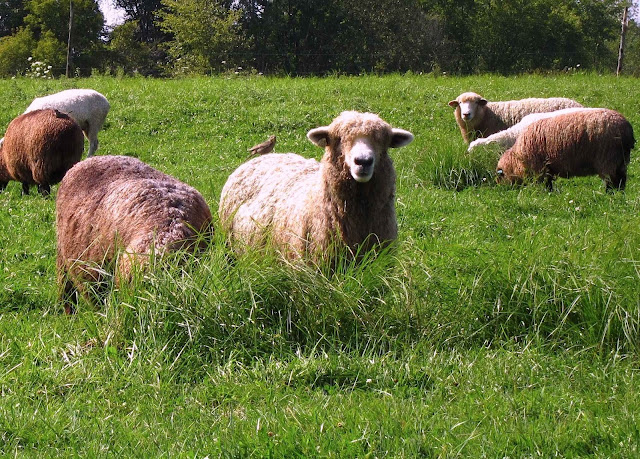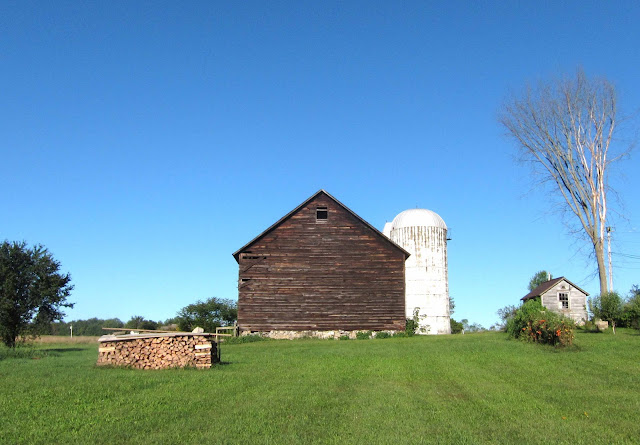Boy, was I glad to wake up to a chilly morning today! Not that I'm eager for summer to go, but I was hoping for thick morning fog along the Hudson River in Northumberland, where I had an assignment to take some photographs of an old family farm that lies in that beautiful valley. Well, if I'd gotten up an hour earlier, I'll bet there were marvelous billows of fog, thick as whipped cream, lying low over the river. As it was, there were still a few wisps rising into the sky to show where the river flows between Saratoga County farmland and the mountains of Washington County.
I'd come to this eastern edge of the county, an area of rolling hills and expansive farmland, to visit the sheep farm of Tom and Carole Foster. Tom was born and reared on this land and now hopes to preserve this pastoral acreage as agricultural land forever, with a conservation easement made possible by Saratoga P.L.A.N., an organization dedicated to preserving farmland and natural areas. I'd been asked by some of the folks in that organization to provide them with some photographs to be used in their fund-raising efforts. To be sure, I'm always glad to tramp about barnyards and meadows, especially on such a splendid morning as it was today, with the early sunlight illuminating the barns and silos so beautifully.
Although this was once a dairy farm, the Fosters now raise only sheep, which are sheared to provide much of the wool that Carole spins and dyes to sell in her yarn shop, now occupying the original Foster farmhouse. Although most of the sheep kept a careful distance away from me, a few ventured close enough to the fence for me to say hello. I was amused to see that a number of sheep bore birds upon their backs.
And what would a sheep farm do without a Border Collie to herd them? This is Meg, and I would have loved to photograph her racing out to the meadow to bring in the flock, but she was way too fast for my camera to track her. Good dog! You should have seen her GO!
The yarn shop, run by Carole and her daughter Abbey, occupies the original farmstead, welcoming knitters and spinners to its homey rooms for conversation around the fireside in winter, or to an outdoor patio under the old shade trees in warmer weather.
I'm not a knitter, myself, but walking through these rooms full of gorgeous colors and textures sure made me think it would be a wonderful craft to take up. While I was admiring these handsome bins containing the yarns, Carole explained that a neighbor had handcrafted them, each one constructed from a different kind of wood, using trees that grew on the neighbor's land. Each bin was labeled on the underside with the kind of wood it was made from.
Since the Fosters operate a farm whose product is fiber, it's fitting that a fund-raiser to benefit the conservation of their farm would be called "A Thousand Fibers: an exhibition of fine art in fiber," to be held at the Spring Street Gallery in Saratoga Springs from September 22 until October 18. I've been told that my photographs of the farm, as well as those of several other photographers, will be displayed in the halls leading into the exhibition, and will also be available for purchase, with proceeds to benefit the farm. In addition, there will be an artists' reception on September 20, with $25 tickets available through Saratoga P.L.A.N.'s website, www.saratogaplan.org.
What a pleasure it was to wander this landscape and think that what I was doing might go to support such a cause. How sad it would be to see such evocative structures as this handsome old barn torn down to make room for mini-mansions.
Or to see these expansive acres of cornfields that spread out beneath a broad blue sky chopped up into half-acre building lots with garages and asphalt driveways.
Some of the fields were fallow, their contoured hillsides left to be taken over by acres of glorious goldenrods.
A few New England Asters had opened among that goldenrod sea, and it didn't take long for the Monarch Butterflies to find their vivid purple blooms.
Other fields were fringed with Queen Anne's Lace, a favorite of the Viceroy Butterfly, a Monarch look-alike that can be distinguished by the black stripe that crosses the hindwings.
The early-morning meadows were festooned with diamond-drop cobwebs, and this one held a very large Striped Garden Spider (Argiope trifasciata), a species of Argiope I had never seen before.
A spider this large is almost certain to be a female, and I was enchanted to see how her multi-striped back and furry underside were spangled with dew.
After wandering the fields and the barnyards, I got in my car and drove down the boundary road that led to the river. This quiet, tree-shaded lane reminded me of the rural roads of my country childhood, where every tree held singing birds and the dew-cooled grass proved a comfort to bare feet achy from walking on gravel.
Perhaps it was those memories of childhood that compelled me to squeeze around a padlocked gate and make my way down to a dam, exactly the kind of benign trespass I assumed was my right as a child. I can see, though, that parents would probably not want their kids to have easy access to such a dangerous site as this hydroelectric dam, constructed by the Washington County village of Ft. Miller across the river.
Even more intriguing, and equally as dangerous, I suppose, were these slippery rocks and fast-moving rapids that lie below the dam.
Dangerous, yes, but oh so beautiful! The Hudson here is so lovely, it's understandable that the land that borders the river would be eagerly sought for real-estate development. Thanks to the efforts of organizations like Saratoga P.L.A.N., we can hope that at least some of this valley will continue to farmed as it has for generations before.
















11 comments:
Nice job with this. The last thing this area needs is more housing developments tearing up farmland.
It's good to get the word out that there ARE ways to preserve open space and a way of life that is rapidly disappearing - through the efforts of many caring people !
Ohhhh! Look at all those balls of colorful yarn . . . and I just recently decided that it's time to start knitting afghans again now that the dog population's down to a manageable level.
Your photos are super today. My favorite is the cornfields and clouds. I'm a sucker for a few good clouds!
Hopefully you'll be pleased to know that one of your photos (not pictured here) will be gracing the front of the invitation to the fundraiser.
The rapids on the Hudson was called "The little carrying place" by the indians...The great carrying place was from Fort Edward to Lake George.
The house on the bend of the dirt loop road was a store in the early 1800's and would charge travelers a fee to "carry" their boat and goods out of the Hudson - around the 'falls' and then put back into the Hudson.
Thanks for all your kind and informative comments, dear readers. I was very interested in learning about the history of the Hudson there at "the little carrying place." I do have a correction to what Benj said, though. The photo of the lamb on the fundraiser invitation is by another photographer whose photos will be included in the show, Jessica Riehl.
Your photos and description of the project matched wonderfully. Those wooden boxes are beautiful. You did a great job highlighting them.
What a beautiful day you had to photograph that farm, too! And oooo - how delicious the yarns and those wonderful bins! Seems like a very special place.
Such a beautiful picture you have shared here. i really enjoy your blog. keep sharing. here you can visit my blog too:)
What a beautiful post....you capture the beauty of the farm not only through your gorgeous photos but through your prose as well.
Post a Comment